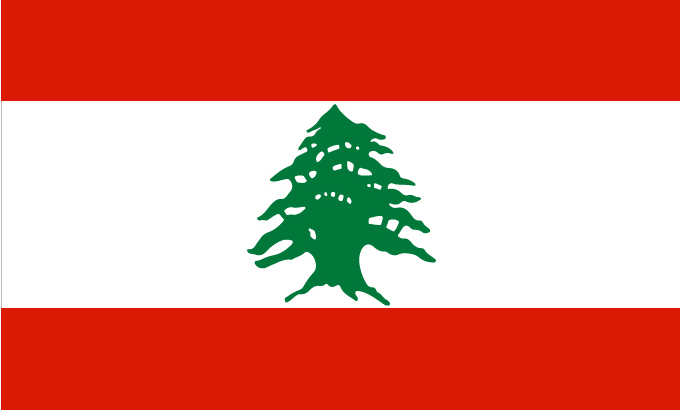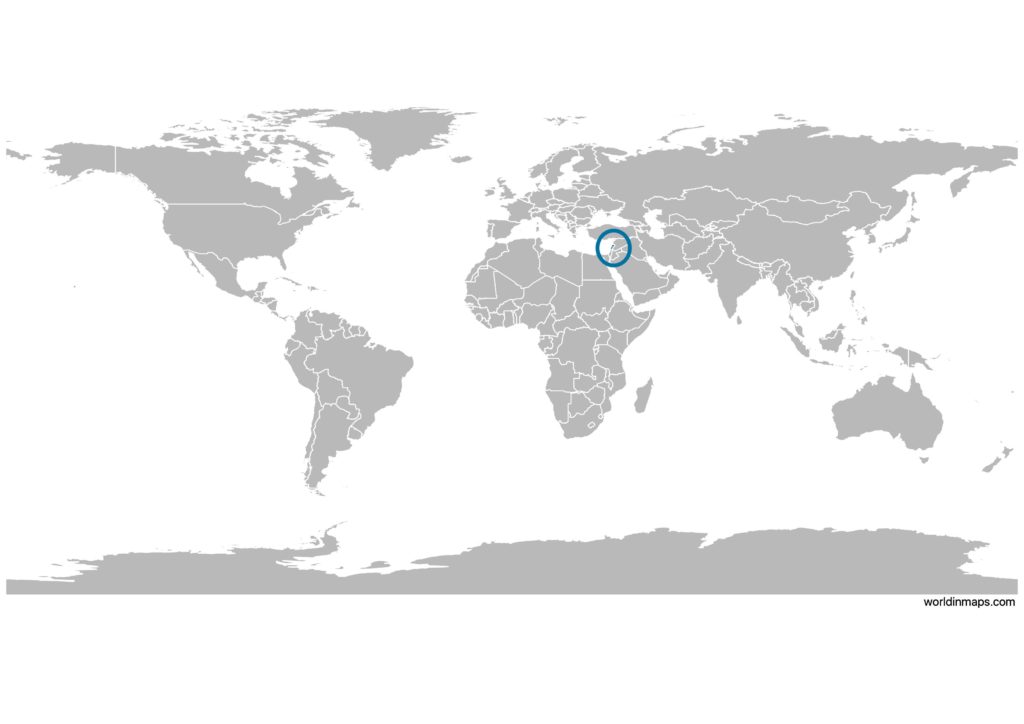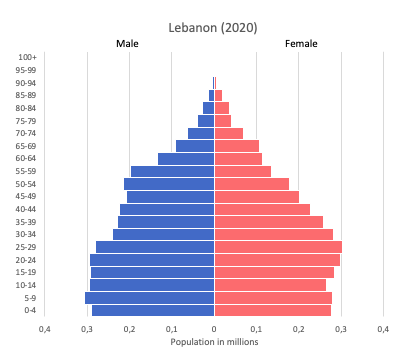Lebanon

| Government | |
| Name | Lebanese Republic |
| Arabic | الجمهورية اللبنانية al-Jumhūrīyah al-Lubnānīyah |
| Government type | parliamentary republic |
| Capital | Beirut (1,916,100) |
| Currency | Lebanese pound (LBP) |
| People | |
| Population (2020) | 6,825,442 (109th) |
| Density of population | 560 P/km2 (21st) |
| Nationality | Lebanese |
| Official languages | |
| Arabic | |
| Ethnic groups | |
| Arab | 95% |
| Armenian | 4% |
| other | 1% |
| Religions (2018) | |
| Muslim | 61.1% |
| Sunni | 30.6% |
| Shia | 30.5% |
| Christian | 33.7% |
| Druze | 5.2% |
| Life expectancy (2020) | |
| Male | 76.9 years |
| Female | 79.8 years |
| Total population | 78.3 years (68th) |
| Homicides | |
| Total (2018) | 2.5 per 100,000 people (91st) |
| Geography | |
| Land area | 10,230 km2 |
| water area | 170 km2 |
| total area | 10,400 km2 (169th) |
| Mean elevation | 1,250 m |
| Lowest point | |
| Mediterranean Sea | 0 m |
| Highest point | |
| Qornet es Saouda | 3,088 m |
| Land use (2011) | |
| Agricultural land | 63.3% |
| Arable land | 11.9% |
| Permanent crops | 12.3% |
| Permanent pasture | 39.1% |
| Forest | 13.4% |
| Other | 23.3% |
| Urbanization | |
| Urban population (2020) | 88.9% |
| Rate of urbanization | 0.75% annual rate of change (2015 – 2020) |
| Economy | |
| Labor force (2016) | 2.166 million (123rd) |
| note: excludes as many as 1 million foreign workers and refugees | |
| Labor force by occupation | |
| Agriculture | NA |
| Industry | NA |
| Services | NA |
| Unemployment rate (2007) | 9.7% (138th) |
| GDP (PPP) (estimate 2019) | |
| Total | $91 billion |
| Per capita | $15,049 (66th) |
| GDP (nominal) (estimate 2019) | |
| Total | $58 billion (82nd) |
| Per capita | $9,655 |
| GDP by sector (estimate 2017) | |
| Agriculture | 3.9% |
| Industry | 13.1% |
| Services | 83% |
| Exports (2017) | $3.524 billion (122nd) |
| Exports partners (2017) | |
| China | 13% |
| UAE | 9.9% |
| South Africa | 7.5% |
| Saudi Arabia | 6.5% |
| Syria | 6.5% |
| Iraq | 5.8% |
| Turkey | 4.6% |
| Imports (2017) | $18.34 billion (80th) |
| Imports partners (2017) | |
| China | 10.2% |
| Italy | 8.9% |
| Greece | 7% |
| Germany | 6.6% |
| US | 6.3% |
| Turkey | 4.5% |
| Egypt | 4.2% |
Lebanon on the world map

Lebanon is located in Asia and more specifically in the Middle East.
Lebanon top 10 largest cities
- Beirut (1,916,100)
- Tripoli (730,000)
- Zahlé (85,000)
- Sidon (75,000)
- Aley (65,000)
- Tyre (60,204)
- Nabatieh (50,000)
- Jounieh (35,500)
- Batroun (35,312)
- Baalbek (10,392)
Demography
Population pyramid

Age structure data
Estimate for 2020:
- 0-14 years: 20.75% (male 581,015/female 554,175)
- 15-24 years: 14.98% (male 417,739/female 401,357)
- 25-54 years: 46.69% (male 1,296,250/female 1,257,273)
- 55-64 years: 9.62% (male 250,653/female 275,670)
- 65 years and over: 7.96% (male 187,001/female 248,479)
Remark: the age structure of a population affects a nation’s key socioeconomic issues. Countries with young populations (high percentage under age 15) need to invest more in schools, while countries with older populations (high percentage ages 65 and over) need to invest more in the health sector. The age structure can also be used to help predict potential political issues. For example, the rapid growth of a young adult population unable to find employment can lead to unrest.
Population from 1950 to 2020
Source: United Nations, Department of Economic and Social Affairs, Population Division (2019). World Population Prospects 2019, Online Edition. Rev. 1.
Evolution of the life expectancy from 1960 to 2018
Source: World Development Indicators, The World Bank
Economy
Agriculture:
citrus, grapes, tomatoes, apples, vegetables, potatoes, olives, tobacco; sheep, goats
Industries:
banking, tourism, real estate and construction, food processing, wine, jewelry, cement, textiles, mineral and chemical products, wood and furniture products, oil refining, metal fabricating
Exports – commodities:
jewelry, base metals, chemicals, consumer goods, fruit and vegetables, tobacco, construction minerals, electric power machinery and switchgear, textile fibers, paper
Imports – commodities:
petroleum products, cars, medicinal products, clothing, meat and live animals, consumer goods, paper, textile fabrics, tobacco, electrical machinery and equipment, chemicals
Time zone and current time in Lebanon
Go to our interactive map to get the current time in Lebanon